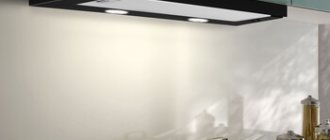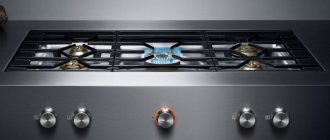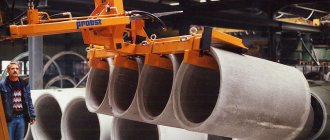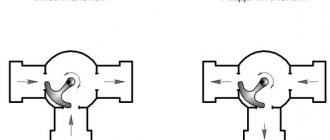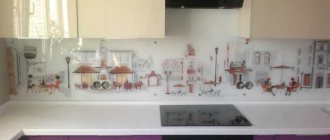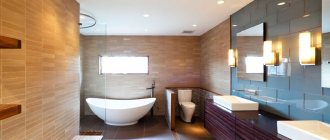Recirculating hoods, which use special filters to purify the air in the kitchen without removing it from the room, are one of the popular types, since their price starts in the budget segment. Such devices are easy to install, even independently, controlled using a simple set of buttons or sliders in mechanical models and push-button or touch in expensive electronic ones. Caring for them most often also evokes positive emotions. Find out what distinguishes units without an air vent from those that require more complex installation, their advantages and disadvantages in our review.
Fireplace hoods for kitchens without venting
Low noise Elica EASY WH/F/50 WHITE
These household appliances embody all modern ideas about aesthetics, ease of use, power and the ability to create a truly cozy atmosphere in the room.
New generation fans built into the design increase the service life of the device, as does high-quality assembly.
Equipped with a grease filter that absorbs tobacco smoke, soot and oil microparticles in a matter of minutes, the housing is easily mounted using prepared fasteners.
Advantages:
- electronic touch control;
- running size width 50 cm;
- processes up to 800 cubic meters. m/h;
- 3 operating speeds are provided;
- additionally 2 modes – intensive and perimetric suction;
- LED lighting of 3 lamps;
- noise level is only 61 dB;
- universal design and color scheme;
- cost from 35,000 rub.
Flaws:
- no carbon filter.
Miele DA 7090 W BK with a width of 100 cm
An ergonomically designed product from a well-known brand looks natural both at home and in a restaurant or bar.
Thanks to the large suction surface area, as well as the presence, in addition to a grease filter, of a carbon filter, the air in the room will be ideally and quickly cleaned without being vented outside. If necessary, you can use not only the standard mode, but also increased power.
The elegant body of the device made of metal and glass will harmoniously complement the interior of the kitchen or living room. Installation of the model in studio kitchens is especially effective.
Advantages:
- touch-based electronic control;
- large built-in width 100 cm;
- production capacity is 550 cubic meters. m/h;
- the unit has 1 motor;
- works in 3-speed mode;
- intensive mode available;
- there is a contamination indicator;
- halogen backlight can be adjusted in intensity.
Flaws:
- noisy 75 dB;
- cost from 90,000 rub.
Best Moon BK 50 - classic shapes and modern equipment
The design and construction of the hood resembles a pendant lamp, so it will not attract unnecessary attention. This is a multifunctional assistant, the body of which is characterized by smooth lines, technical capabilities - high performance, and convenience - maximum comfort.
With the help of two complementary filters at once, the degree of air purification achieves excellent results. Moreover, the absorption of odors and burning occurs both directly above the hob surface of the stove and on the periphery of the room area.
Advantages:
- modern electronic touch control system;
- ceiling installation with a typical installation width of 50 cm;
- the unit processes 550 cubic meters. m of air per hour;
- large speed range – 4;
- halogen lighting with 3 lamps;
- 2 filters – carbon and grease;
- It is technically possible to equip the hood with a remote control;
- cost from 40,000 rub.
Flaws:
- the need to replace the carbon filter;
- maximum permissible noise level 69 dB.
Mini sizes and maxi capabilities from Faber Zoom Isola XA 40
Such compact equipment, according to reviews from owners, efficiently purifies the air in small rooms and is as convenient as possible to operate.
It is enough to set a timer or pick up the remote control to control the process of purifying the air from various types of contaminants from a distance. If you are not used to paying attention to minor odors, the contamination indicator will tell you when to turn on the useful device.
The shiny silver surface of the metal body, illuminated by 4 light bulbs, is reminiscent of an original high-tech ceiling installation.
Advantages:
- electronic control;
- high-performance work – 830 cu.m. m/h;
- the intensive mode is additionally activated;
- there is a contamination indicator;
- 3-speed mode;
- integrated timer;
- includes a remote control;
- halogen adjustable backlight of 4 lamps;
- low noise model - 66 dB;
- compact dimensions 40x40 cm.
Flaws:
- no carbon filter;
- cost from 75,000 rub.
The principle of operation of a hood without venting to ventilation
Hoods that do not exhaust air clean it using a carbon filter. Installation is carried out directly above the hob. The hood works on the principle of air circulation through a carbon filter element installed at the base of the device. This creates a cycle in which polluted air, passing through the filter, is cleaned and returned back to the kitchen area. This device provides excellent air purification and is installed without the use of additional pipes to remove odors to the street.
The main disadvantage is the high cost of carbon filters; you should also take into account the fact that they must be regularly replaced. Many experts agree that the use of this system makes it possible to save money and time only at the time of installation. In the future, operation will require constant expenses for replacing filter elements, their additional cleaning and washing, which reduces the attractiveness compared to classical systems.
Hoods are widely used in old buildings, in which ventilation ducts are insufficiently developed or are completely absent. In this case, it is possible to ensure that air is vented outside directly through the wall, but this is a rather costly and difficult process to implement.
Built-in kitchen hoods without venting to ventilation
Smeg KSC90B - for ceiling
Despite the standard rectangular shape, the hood complements the interior of the room well thanks to the use of innovative materials, thoughtful lighting and the ability to control the system remotely.
All that remains is to carefully install the durable metal and glass structure on the ceiling and, with the help of detailed instructions, master the simple settings of high-performance equipment.
Almost inaudible noise during operation of the unit will also add positive emotions. This model is perfect for large premises for a number of indicators.
Advantages:
- operates using an electronic control type;
- engine power potential is 220 W;
- large width of the built-in surface 90 cm with a height of 19 cm;
- 830 cubic meters are cleaned within an hour. m of air in a closed cycle;
- there are intensive and interval modes;
- 4 operating speeds with convenient switching;
- perimeter suction option;
- lighting with 3 LED lamps;
- remote control using a remote control;
- low noise unit – 50 dB.
Flaws:
- only a grease filter is provided, no carbon filter;
- average cost 140,000 rub.
FALMEC Downdraft 600 120 WH – for table
The equipment meets all modern ideas about the quality of assembly and operation, convenience and installation ergonomics. Despite its impressive dimensions, the model can be easily integrated under the tabletop, saving space and expanding the concept of a stylish interior.
Remote control capabilities allow you to fully enjoy clean air. The only significant drawback of the hood is its price, which is included in the premium category.
Advantages:
- touch type electronic control system;
- high performance – 960 cu.m. m/h;
- 4-speed mode;
- 2 filters are used - carbon and grease;
- timer function;
- there is a remote control unit;
- 120 cm built-in width;
- minimalist design;
- innovative engine;
- optimal noise level 66 dB.
Flaws:
- low illumination with 1 lamp 8 W;
- cost from 160,000 rub.
Design
Unlike the flow-through method of indoor air purification, recirculation requires a filter system. They must remove fumes, fumes, oily particles and other by-products of heat treatment of products from the air. At the same time, elimination does not imply their removal to the outside.
A ductless hood is usually equipped with two levels of filtration. The first is a mesh filter installed in the air intake, onto which fat particles settle. The material for its manufacture is aluminum or stainless steel. If the grid is significantly dirty, you can remove it and wash it in running water. The second level provides fine filtration and can consist of:
- Acrylic reusable liners that are hand washable.
- Disposable from paper, padding polyester or non-woven fabric.
- Carbon filters that retain both combustion products and most odors.
The principle of operation of a hood without an air duct
The principle of operation of a conventional hood is known to everyone. Cooking food on the stove is not a seamless process. Processes of evaporation of products occur. The air becomes heavy and dirty. When you turn on a regular hood, steam and smoke begin to be sucked into the cavity of the device. With the help of a built-in fan, polluted air is removed outside the kitchen, to the street or into the ventilation shaft. What is the principle of operation of a system without an air duct? The answer is simple. These hoods recirculate air.
Contaminated steam is drawn into the device. Passing through the filter system, it returns again to the kitchen space. The hood itself, without an air duct, differs from the usual, more complex filtration system, consisting of two levels. The first is designed to trap grease and dirt. This type of cleaning is rough. The material of the filtration elements is aluminum or acrylic. The filters are easy to clean, both by hand and in the dishwasher. The second, coal, purifies the air. The flow, passing through this filter, is completely cleaned of foreign odors and grease residues.
There is an important disadvantage of the second stage of filtration. This element quickly becomes unusable. The service life of the carbon filter is 3-4 months. After its completion, you need to install a new element. Sometimes, replacing an important part of the hood can be postponed until a later date. This happens in cases of rare use of stoves and the ventilation device itself, and when there is no smoking in the room. But, even if the service life increases by 1–2 months, this does not save the owner of the equipment from purchasing a new, expensive filter.
Advantages of recirculation models
A kitchen hood without a ventilation outlet is not only easy to install, it is also perfect in cases where the possibility of ventilation outlet is limited or non-existent. An example is old high-rise buildings where the ventilation shaft is common to several apartments. In this case, the flow apparatus may create inconvenience for neighbors. The circulation analogue eliminates such problems. Its advantages:
- simplicity and efficiency of installation;
- saving installation costs;
- a free ventilation grille maintains natural ventilation;
- keeping warm in winter.
Disadvantages of circulation
From the point of view of ease of installation, most often you want to choose a hood without an air duct. But before making a final decision, in addition to the advantages, you should also get acquainted with its disadvantages:
- a hood with cassettes without a pipe requires more careful and frequent maintenance;
- the presence of replaceable elements increases operating costs;
- in terms of performance, a hood with a filter without an outlet is inferior to its analogues, losing up to 50% of power on the cleaning elements;
- In terms of noise, such models are inferior to flow-through competitors;
- inability to remove moisture - the equipment is limited to eliminating burning, odors and grease particles;
- relatively limited choice of shapes, sizes and designs.
Installation benefits
Installing such a hood is much easier. There is no need to route an air duct or corrugated pipe to the hole in the ventilation column.
Enough:
- Select the required installation space depending on the type of structure above the hob or stove.
- Mark the fasteners.
- Drill the necessary holes and secure the device with pre-prepared screws.
After this, you can connect the device to the network and test for proper operation. Having gone through all the stages, you can proceed to full operation of the device.
Design and principle of operation of the hood - general information
The design of any hood is elementary. It consists of a motor that drives the fan and filters that trap fumes, soot and odors.
The fan creates air draft and forces polluted air to pass through the filters. But where it goes next depends on the operating mode of the hood.
Exhaust device diagram
There are only two such modes: exhaust and circulation. Although almost all modern models can work in any of these modes depending on your needs.
In the photo above you see a diagram of such a combined hood, where 1 is a grease filter, 3 is a motor, 4 are mounting holes, and 5 is an anti-return valve. These positions are available in any type of exhaust device.
Now let's talk about the differences.
- Exhaust mode is when polluted air is discharged into a ventilation shaft or outside, that is, outside the room. To do this, an air duct (7) is connected to the hood using a clamp (6), through which the air drawn in by the fan is removed.
- The circulation mode is based on cleaning the air and returning it back to the room. In this case, there is no need for an air duct, but the device is equipped with an odor-catching carbon filter (2) and holes for the outlet of purified air (8).
We will talk about filters in more detail later, but now let’s talk about why a kitchen hood without a vent is good and why many experts recommend giving it preference.
Read the article “How to choose a hood for the kitchen - solving the problem in three steps.”
Features of care
Kitchen hoods without a ventilation outlet will require more attention. The main problem is the need to regularly clean or replace filter elements. Disposable inserts must be replaced with new ones each time. Acrylic, aluminum and carbon cleaners need to be washed. Depending on the type of element, cleaning should be done once every 3-6 months . To understand whether they need to be washed, just inspect the filters.
Technological models are equipped with a filter filling indicator, the activation of which serves as a signal about the need for replacement or cleaning. Maintenance features are always written in the instructions for each specific model.
Advantages and disadvantages
Hanging recirculating hood
The advantages of ductless hoods include:
- ease of installation - due to the absence of an air duct and the need to connect to ventilation, it can be easily built into a kitchen cabinet;
- low noise level;
- the ability to fit into the design of any kitchen;
- economical - consume less electricity from the network.
The main disadvantage of the devices is the need for constant replacement of filter elements and the associated costs.
How to choose
In order for a kitchen hood without an air duct to optimally fit into the given conditions and maintain the required level of functionality, it is important to choose the right one. To do this, you need to take into account the design of the structure, its performance, brand reputation and other properties.
During the selection process it is recommended:
- Pay attention to the productivity or speed of air purification in the room - it is calculated by multiplying the volume of the kitchen by the average air purification level of 12.
- Evaluate the set of functions and cleaning levels, select the most important ones, so as not to pay for unnecessary ones.
- Select the design of the device and the type of installation to maintain the unity of the kitchen design.
- Consider cleaning elements - if you rarely use the stove, aluminum versions will be sufficient, but frequent cooking will require more reliable and capacious charcoal cassettes.
- Check the device for noise - it is better that it does not exceed 50 dB.
Photo of kitchen hoods
Read here How to make a kitchen with your own hands: 50 photos of the relevance of homemade furniture
Did you like the article? Share 
Popular models and brands
A reliable manufacturer will be an important condition for a successful choice. It is recommended not to give preference to little-known brands, despite the attractive prices. A kitchen hood with filtration and ductless from a reputable manufacturer is a reliable guarantee of trouble-free operation. Among these brands often mentioned are:
- Siemens;
- Bosch;
- Kronasteel;
- Hansa.
Siemens LI 28031 IX
Built-in version with an optimal set of functions for a small kitchen. The reputation of the famous German brand serves as a sufficient guarantee of high quality and durability. Adapted for operation without exhausting fumes outside, it is quite functional in its price segment.
- compact;
- three speed modes;
- two grease cleaners;
- Comfortable and fairly bright lighting.
- in the third mode it is quite noisy;
- to turn on the light, you need to pull out the panel, which turns on the hood itself;
- When installing, the screws are difficult to screw in.
Bosch DHU 646U
Budget version with suspended installation. Can operate in drain and circulation modes. Halogen lamps are used for lighting, which consume a minimal amount of electricity. Grease filters are easy to remove for cleaning.
- acceptable power and performance for the segment;
- slider design of the receiving panel;
- grease cleaning system;
- twin-motor design with three speeds.
There are no serious shortcomings; user reviews are positive.
Krona Lana 500 White
One of the cheapest models with good functionality. The brand is less well known than its German competitors, but quite popular and reliable.
- maximum availability;
- the ability to combine recirculation with exhaust;
- good performance;
- effective air filtration in the kitchen.
- somewhat old-fashioned, angular design;
- slightly increased noise.
Hansa OSC 6060 IH
Another economical option for a hood with a dome layout and the ability to work without outlet to the ventilation shaft. A well-known brand ensures impeccable assembly and long service life.
- decent power;
- good level of cleaning;
- ease of control.
- noisiness;
- lack of intensive mode;
- using an incandescent lamp as illumination.
Before purchasing a range hood, also consider the frequency and intensity of cooking. The circulation model may not cope with the abundance of evaporation and other results of heat treatment of products. Therefore, the modern recirculation option most often works according to a combined scheme, in which a discharge can be organized.
